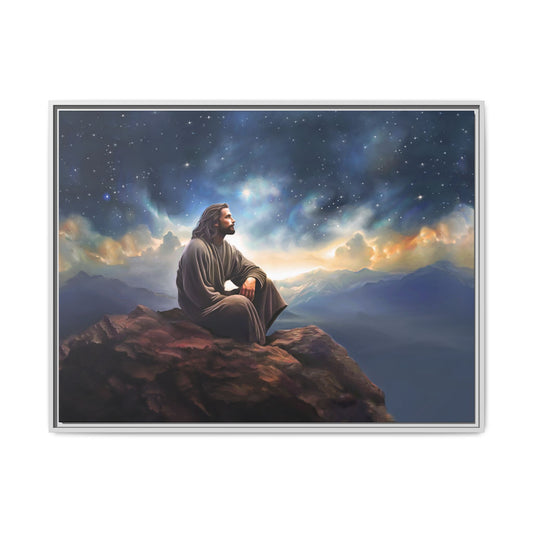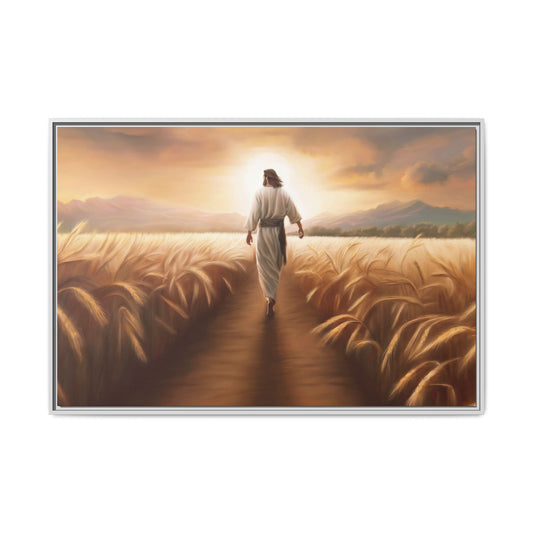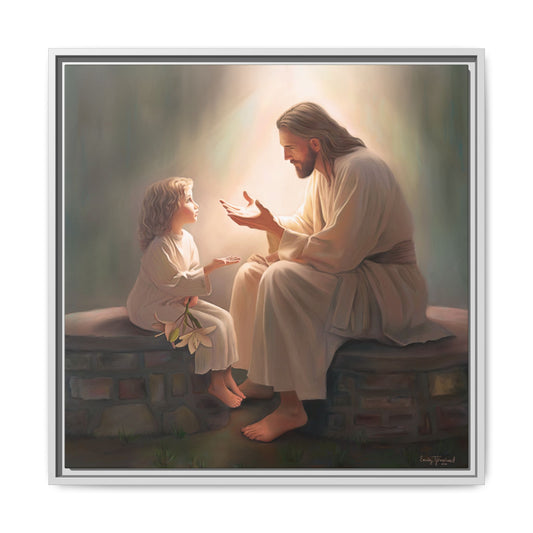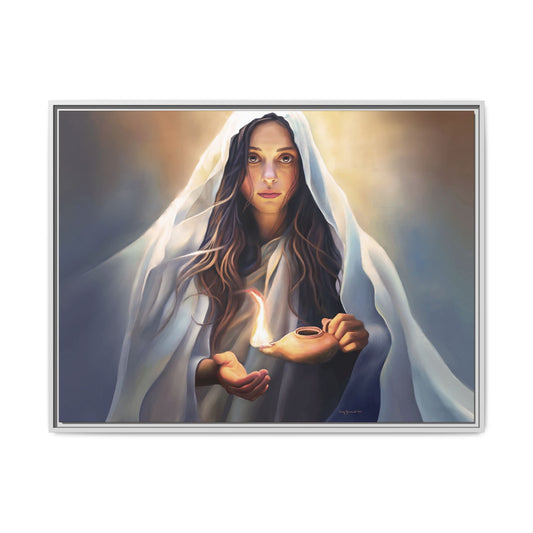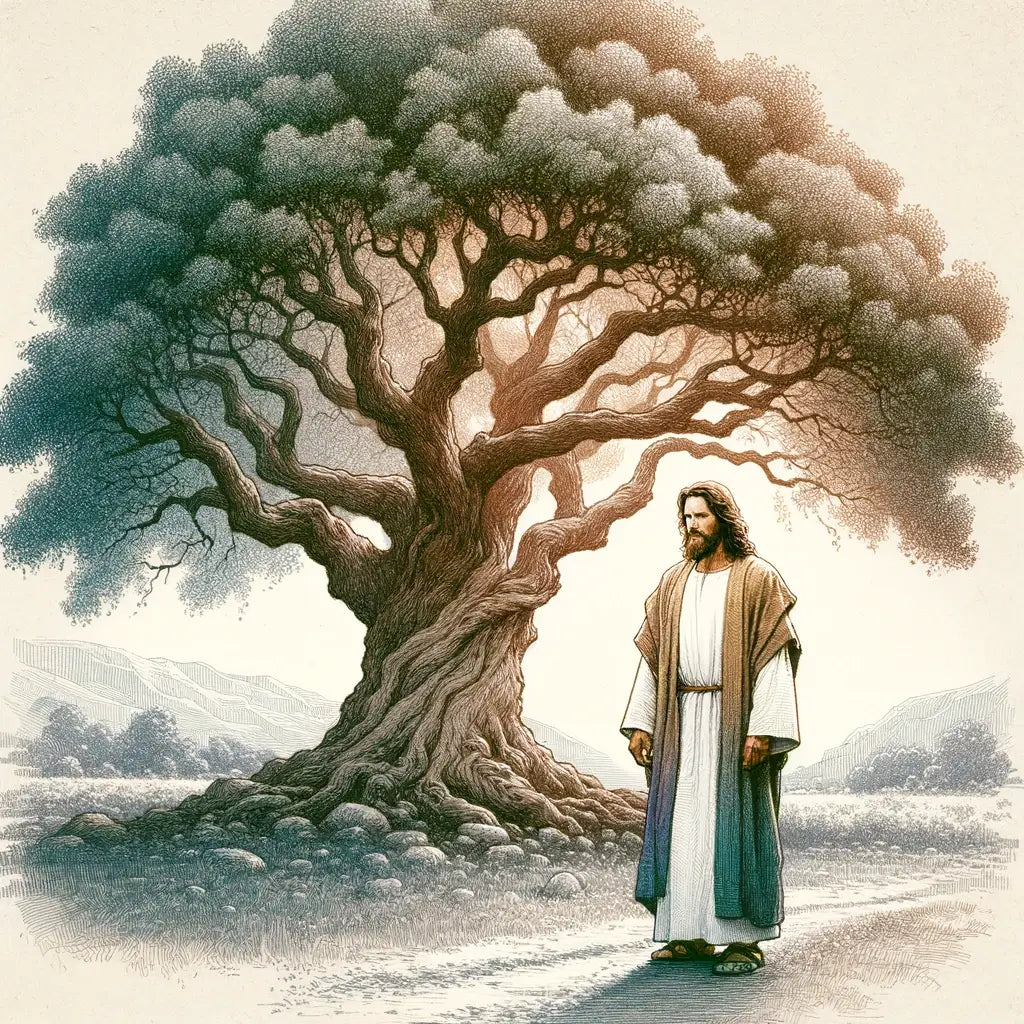
Inspiring Jesus Drawings and Artwork
Share
We've all been captivated by Jesus Christ's inspiring presence. But have you ever seen his image depicted in artwork? From the iconic Christ Pantocrator icon to drawings and paintings in Italy and Syria, the early Christian era is full of captivating Jesus art. Join us as we explore the fascinating symbolism and history behind Jesus' depictions in early Christian art. From the powerful brushstrokes of early artists to the spiritual lessons we can learn from these drawings, we'll uncover the inspiring message of Jesus in these magnificent works of art.





























 These various depictions allow us to gain further insight into Jesus and His teachings. It can be a powerful tool to use in our own spiritual journeys, as it encourages us to contemplate the meaning of Jesus, and His role in our lives.
These various depictions allow us to gain further insight into Jesus and His teachings. It can be a powerful tool to use in our own spiritual journeys, as it encourages us to contemplate the meaning of Jesus, and His role in our lives.
Key Takeaways
- The Christ Pantocrator icon is believed to be what Jesus looked like and is often associated with the title 'ruler of all' or 'almighty'.
- Early depictions of Jesus showed a younger, clean-shaven Jesus with short hair, while traditional images portrayed him as older and bearded, symbolizing wisdom and the role of a teacher.
- Some early Christian art depicts Jesus holding a wand, symbolizing the miraculous acts performed by Jesus.
- Early Christian art is not meant to be a literal representation of Jesus but a theological depiction, with different elements and symbols conveying specific theological messages.

Exploring the Power of Visual Representation in Religious Contexts
We are exploring the power of visual representation in religious contexts, particularly in regards to Jesus drawings and artwork. These depictions of Jesus play a significant role in worship and can serve as an aid for meditation and reflection. We'll discuss the historical significance of Jesus drawings and their impact on worship.Discussing the Historical Significance of Jesus Drawings and Their Impact on Worship
How have Jesus drawings and artwork impacted religious worship throughout history? From the Christ Pantocrator Icon in Saint Catherine's Monastery to depictions of Jesus healing a paralytic in the Catacombs of Callixtus, early Christian art has played a significant role in religious worship.- It captures stories from the Bible, giving them visual form.
- It conveys specific elements for theological reasons.
- It symbolizes the role of Jesus as teacher and symbol of blessing.
- It can serve as aids for meditation and reflection.

Highlighting the Role of Jesus Portraits as Aids for Meditation and Reflection
Frequently, Jesus portraits can serve as powerful aids for meditation and reflection in religious contexts. Whether it be the Christ Pantocrator Icon, an early depiction of Jesus with a wand, or the Good Shepherd Mosaic in Italy, these pieces of art represent a rich history of faith and can be used as powerful tools to help people reflect on the teachings of Jesus Christ. While the early depictions of Jesus provide insight into the intersection of art, history, and theology, these portraits can also be used to connect with Jesus on a deeper level. By focusing on the image, one can enter into a place of prayer and meditation, allowing them to be inspired by the image and draw closer to God. Jesus portraits aren't just a representation of faith, but an aid to help people meditate on the teachings of Jesus.
Types of Jesus Portraits
We will explore the various types of Jesus portraits, from traditional to modern interpretations, and even those created by children. Each type of portrait will be discussed in detail, looking at their unique features and symbolism. We'll also consider how these portraits can be used as a source of inspiration and contemplation.
Traditional Jesus Portraits
We explore traditional depictions of Jesus in art history, examining how Renaissance and Baroque styles have influenced Jesus portraits. Comparing these styles across different time periods, we can gain insight into the ever-evolving interpretations of Jesus.Examining Classic Depictions of Jesus in Art History
Although there are many interpretations of Jesus in art history, one of the most prominent types is the traditional Jesus portrait. Examples include the Christ Pantocrator icon, early depictions of Jesus with a wand, mosaics from Italy (e.g. Good Shepherd), paintings from Rome (e.g. Jesus and his Apostles), and the painting in Dura-Europos. These artworks show a range of symbolism and interpretations, reflecting the intersection of history, art, and theology. This section of the article will discuss the influence of renaissance and baroque styles on Jesus portraits.
Discussing the Influence of Renaissance and Baroque Styles on Jesus Portraits
As we explore traditional Jesus portraits, we can see the influence of Renaissance and Baroque styles in many of these depictions. Jesus Drawings often feature clean lines, bright colors, and a naturalistic approach to the human form. Paintings of Jesus tend to emphasize his holiness and divinity, while still capturing his human features. These portraits often focus on his solemn expression, long hair, and beard, or his gentleness and humility. Through these depictions, Jesus is seen as a loving and compassionate figure. This transition of styles has shaped the way we view Jesus today. We can now move on to considering how modern interpretations of Jesus Drawings and Paintings have evolved.
Modern Interpretations
In modern interpretations of Jesus, artists have begun incorporating more diverse cultural representations into their artwork. These representations often reflect a range of cultural backgrounds and religious beliefs, allowing viewers to gain a more comprehensive understanding of Jesus.
Exploring Contemporary Approaches to Depicting Jesus in Art
We explore contemporary approaches to depicting Jesus in art, examining types of Jesus portraits and modern interpretations. From mosaics, paintings, and sculptures to street art, digital media, and other forms: 1) Modern images of Jesus may include different hand gestures, clothing styles, and symbols. 2) Diverse interpretations of Jesus may range from playful to serious. 3) Pictures of Jesus may be a representation of an individual's faith. 4) Images of Jesus reflect the message the artist desires to portray. Modern images offer a unique insight into the intersection of faith, art, and culture.
Discussing the Incorporation of Diverse Cultural Representations in Modern Jesus Portraits
From global cultures to modern art movements, we explore how diverse cultural representations are being incorporated into modern Jesus portraits. From depicting Jesus as a good shepherd to a loving family member, these portraits strive to capture true aspects of Jesus' character. By incorporating cultural elements, modern Jesus portraits are being crafted that better reflect the values of many global communities. They're designed to bring the good news of Jesus to all, in a way that's meaningful and relatable.
Children's Jesus Portraits
Introducing children to Jesus through art can be a powerful tool to help them develop a meaningful relationship with Him. Through books, illustrations, and other visual forms of art, children can learn about Jesus and his teachings in a way that speaks to their young minds. In this article, we'll explore the importance of introducing Jesus to children through artwork and highlight some of the notable children's books and illustrations featuring Jesus.
Discussing the Importance of Introducing Children to Jesus Through Art
It is important for us to introduce children to Jesus through artwork, specifically through children's Jesus portraits. To draw the audience in and keep them interested, here are 4 reasons why: 1) Pictures of Jesus help children understand His teachings. 2) Images of Jesus help children to relate to Him. 3) Children's Jesus portraits foster a spiritual connection. 4) Visual representations of Jesus Christ encourage children to serve others. Showing children pictures of Jesus can help them develop a meaningful relationship with Him.
Highlighting Notable Children's Books and Illustrations Featuring Jesus
Building on the importance of introducing children to Jesus through artwork, notable children's books and illustrations featuring Jesus come in many forms. From special view galleries of Jesus to stories that feature Him, children can gain insight into His life and teachings. Jesus portraits help create a visual connection to Jesus' life and teachings, giving children an opportunity to gain a special view into His world. These special view galleries of Jesus can be the beginning of a lifelong journey of faith.
Insights from Jesus Portraits
Through Christ portraits, we can gain insights into the intersection of history, art, and theology. From the earliest depictions of Jesus to more modern artwork, each image offers its own unique interpretation and symbolism.Theological Reflections
By examining Jesus drawings and artwork, we can gain insight into the different aspects of Jesus' character and teachings. Artists often employ symbolism and metaphor to convey a theological message, allowing us to reflect on the implications of Jesus' life, death, and resurrection. Studying these works of art can help us gain a deeper understanding of our faith.
Examining How Jesus Drawings Can Inspire Theological Contemplation
As we look to the many Jesus drawings and artwork from past centuries, we can gain insights into how these works can inspire theological contemplation. From the Christ Pantocrator icon to the Catacombs of Callixtus, there are many inspiring images to consider. 1) One aspect to explore is the symbolic meaning of hand gestures. These gestures can convey different messages and invite deeper reflection on Jesus' teachings and actions. 2) Another interesting aspect is how clothing styles and facial features are used to convey different aspects of Jesus' character and teachings. Artists throughout history have depicted Jesus in various ways to emphasize different aspects of his identity. 3) Additionally, the representation of Jesus with a wand is a fascinating subject to explore. This unconventional portrayal offers a unique perspective on Jesus' power and authority. 4) Lastly, the use of mosaics to depict Jesus as the Good Shepherd is a powerful visual representation. These mosaics can evoke feelings of comfort and guidance, reminding us of Jesus' role as our shepherd and protector. Examining these works can provide a living image of Jesus that can help the church connect with its past. It allows us to appreciate the diversity of artistic expressions and the richness of theological contemplation that can arise from studying these works.
Discussing the Ways in Which Artists Convey Different Aspects of Jesus' Character and Teachings
Drawing on Jesus portraits from centuries past, we explore how the symbolism used conveys different aspects of Jesus' character and teachings. From the Christ Pantocrator icon to other early depictions, hand gestures, clothing, and more have symbolic meanings. We examine the intersection of history, art, and theology, and how an artist's interpretation can bring light to Jesus' word. With visual representations like mosaics and paintings, we can gain deeper insight into the divine message and how we can serve others.
How Societal and Cultural Factors Shape the Portrayal of Jesus in Art
Societal and cultural factors can greatly influence the way Jesus is portrayed in artwork. From early icons of Jesus to the Christ Pantocrator image, artwork of Jesus has evolved over time. Different interpretations and symbols used in Christian art are believed to convey theological messages. Mosaics and paintings in Rome, Catacombs, and Dura-Europos contain elements that reflect the religious and cultural beliefs of the time period. For example, the Good Shepherd mosaic and the Adoration of the Magi painting both showcase how belief in God and the Christian faith can shape our view of Jesus.
Prominent Artists and Their Jesus Drawings
Throughout the centuries, many renowned artists have created iconic Jesus drawings. From early icons to modern art, these artists have used their creativity and skill to capture Jesus in a variety of ways. Let's take a look at some of the most notable artists in Jesus portrait history.
Notable Artists in Jesus Portrait History
Throughout history, many prominent painters, sculptors, and illustrators have created inspiring depictions of Jesus. Their unique artistic styles have contributed to the art genre. We'll now explore the works of some of these influential artists.Briefly Introducing Influential Artists Who Have Depicted Jesus in Their Work
We've explored the history of Jesus drawings and artwork, now let's take a look at some of the prominent artists who've depicted Him in their work:- Michelangelo
- Raphael
- Caravaggio
- Rembrandt.

Discussing Their Unique Artistic Styles and Contributions to the Genre
We take a look at the unique artistic styles of some of the most notable artists in the history of Jesus portraits. From the Catacombs of Callixtus to the world's oldest surviving church in Dura Europos, these top versions of biblical scenes depict the story of Jesus in a powerful way. Many artists have reimagined the traditional depictions of Jesus in creative ways, each with their own unique style of interpretation.
Iconic Jesus Drawings
We will explore the impact and enduring popularity of iconic Jesus drawings by examining some of the most famous and widely recognized pieces of artwork. In particular, we'll focus on the works of prominent artists who've created inspiring images of Jesus throughout history.
Examining Famous and Widely Recognized Jesus Drawings
There are many iconic Jesus drawings and artwork created by prominent artists throughout history that we can explore. From the Christ Pantocrator icon to the Good Shepherd mosaic, these images provide a glimpse into how Jesus was interpreted and viewed in early Christianity. They depict Jesus as a savior, teacher, and miracle worker, reflecting the story of the New Testament. From paintings in the Catacombs of Priscilla to the healing of the paralytic in Dura-Europos, these famous and widely recognized Jesus drawings offer insights into the impact and enduring popularity of these iconic images.
Exploring the Impact and Enduring Popularity of These Iconic Images
Exploring the impact of prominent artists and their iconic Jesus drawings, we can see how these images have endured in popularity throughout the centuries. Jesus is often depicted as a man of gods, healing the sick and walking on water, and these powerful depictions have inspired artists and viewers alike. From the earliest Roman-like depictions to the Christ Pantocrator icon, these images remain an integral part of Christian art and culture.
Analyzing the Deeper Meanings Conveyed Through Artistic Choices
By examining the artistic choices made in early depictions of Jesus, we can uncover deeper meanings of these inspiring drawings and artworks. From the Christ Pantocrator icon to the Good Shepherd mosaic, each piece conveys sign, cards, and books that evoke emotion and captivate the audience. While the imagery can vary, the symbolism remains constant, showing Jesus as a teacher and a source of blessing. We can better understand these works by analyzing the cultural interpretations of each piece.
Cultural Interpretations
Throughout history, Jesus has been depicted in art in a variety of ways, reflecting the different cultures and beliefs of the artist. From the ancient catacombs of Italy to the murals of Syria, Jesus is represented in art in a multitude of ways. It's important to recognize the diversity of these interpretations, as each offers insight into how Jesus has been viewed globally.
Discussing the Importance of Diverse Representations for a Global Audience
As a global audience, we can appreciate the diverse interpretations of Jesus seen in artwork throughout history. From the earliest of sketchings of Jesus to the more modern interpretations, each culture has interpreted what Jesus may have looked like differently. This is important as it allows us to appreciate the different interpretations of the same figure and encourages us to learn more about our own faith and beliefs. It also allows us to better understand and appreciate the beliefs of others. These diverse representations of Jesus are a critical part of our global understanding of religion and faith.
Jesus Drawings as Spiritual Tools
Drawing and studying Jesus in art can be a powerful spiritual tool. It can be used as a meditative practice, to enhance worship and prayer, and to gain deeper insight into the teachings of Jesus. Through our exploration of Jesus drawings, we can uncover a spiritual truth beyond the physical image
Meditative Practices
As Christians, we often use Jesus drawings as spiritual tools to help us contemplate and meditate on our faith. Jesus portraits can be used to help us quiet our minds and become more aware of our relationship with God. In this article, we'll explore how Jesus drawings can facilitate this spiritual practice and provide practical tips for incorporating them in our personal devotions.
Enhancing Worship and Prayer
Jesus drawings and artwork can be powerful tools for enhancing worship experiences and deepening prayer life. Through visual representation, these art pieces can bring to life the stories and characters in the Bible, stirring emotions and connecting us with God on a more personal level.
Discussing the Role of Jesus Drawings in Enhancing Worship Experiences
We can use Jesus drawings as spiritual tools to enhance our worship experiences. From the earliest icons of Jesus to modern depictions, drawings can provide inspiration and insight. 1) They can be used to tell stories of Jesus' life and ministry. 2) They can be used to encourage and remind us of God's love and grace. 3) They can be used to help us connect with Jesus and his teachings. 4) They can be used to foster a deeper understanding of Christian theology. Jesus drawings can be powerful tools for deepening our spiritual lives and enriching our worship experiences. Next, we'll explore how art can help to deepen and enrich our prayer lives.
Highlighting the Ways Art Can Deepen and Enrich One's Prayer Life
Using art as a spiritual tool, we can build a deeper and more meaningful relationship with God through prayer. Jesus drawings and artwork can help us explore the divine and express our faith in creative ways. From mosaics to paintings, each image can bring a unique perspective to our spiritual journeys. Through art, we can deepen our prayer life, enrich our worship experiences, and reflect on the stories of Jesus. As we explore these images, we can find inspiration, solace, and joy. Art serves as a powerful reminder of the connection between God and us.
Conclusion
We have explored the origins of Jesus drawings and their various interpretations in early Christian art. Jesus drawings can be powerful spiritual tools that offer insight into faith. In this article, we've discussed the ways in which Jesus drawings can be used to connect to personal spiritual journeys.Encouragement and Invitation to Explore the Power of Jesus Drawings in Personal Spiritual Journeys
Our exploration of inspiring Jesus drawings and artwork has led us to a place where we can draw on their power in our own spiritual journeys. We can be encouraged to explore the various depictions of Jesus in art, and use them to reflect on the spiritual side of our lives. These various depictions allow us to gain further insight into Jesus and His teachings. It can be a powerful tool to use in our own spiritual journeys, as it encourages us to contemplate the meaning of Jesus, and His role in our lives.
These various depictions allow us to gain further insight into Jesus and His teachings. It can be a powerful tool to use in our own spiritual journeys, as it encourages us to contemplate the meaning of Jesus, and His role in our lives.

